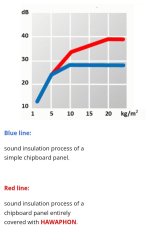Hi folks,
Most of you might be aware that sand does absorb vibrations throughout the friction of particles. However I'm looking and unable to find more information about it, such as.
-Particle inertia, that is, dampening degree vs the required frequency for absorption.
-Enclosure vertical size limitation. The problem here is the potential compacting of sand because of gravity, leaving the bottom departments compressed and less effective.
-Particle grain size effectiveness and shapes
-Particle grain variety.
-Does mixing the sand to a degree with liquid (oil, water) increase the amount of dampening?
-Are another additives to the sand to be recommended? For example perlite/vermiculite to add air pockets and reduce gravity compression?
Most of you might be aware that sand does absorb vibrations throughout the friction of particles. However I'm looking and unable to find more information about it, such as.
-Particle inertia, that is, dampening degree vs the required frequency for absorption.
-Enclosure vertical size limitation. The problem here is the potential compacting of sand because of gravity, leaving the bottom departments compressed and less effective.
-Particle grain size effectiveness and shapes
-Particle grain variety.
-Does mixing the sand to a degree with liquid (oil, water) increase the amount of dampening?
-Are another additives to the sand to be recommended? For example perlite/vermiculite to add air pockets and reduce gravity compression?
Last edited:
look for hawaphon from Korff (Switzerland)
they measured up to 50 db damping
https://www.korff.ch/en/hawaphon-en-2/
they measured up to 50 db damping
https://www.korff.ch/en/hawaphon-en-2/
Attachments
I have sand in the bottom of my Vienna Acoustics Bachs. it definitely makes a difference. without sand, it is a bit boomy. with the sand, the bass is might tighter. i attribute this to damping the sidewalls so they dont resonate, and to adding more weight to the speaker enclouse to keep it well planted on the floor.
I am considering creating a small compartment in my new DIY speakers to add sand at the base as well. But I run these new towers sealed, so any effect might be less noticable.
I am considering creating a small compartment in my new DIY speakers to add sand at the base as well. But I run these new towers sealed, so any effect might be less noticable.
If your design was an MTM and symmetrical, you could just flip the cabinets and swap L -> R every so often.The problem here is the potential compacting of sand because of gravity,
Member
Joined 2006
Linkwitz used 3:1 mixture of water based asphalt emulsion and sand to do the damping job on thin plywood enclosure (1978).
(on page 17 of the Part I article from the link below.) 😀
https://www.linkwitzlab.com/Removed pages/x-sb80-3wy.htm
(on page 17 of the Part I article from the link below.) 😀
https://www.linkwitzlab.com/Removed pages/x-sb80-3wy.htm
Last edited:
I recall reading about a composite material made up of three components each with a different stiffness or internal wave propagation velocity. This results in lots of diffraction of a wave front trying to travel through the material as it encounters each boundary. I think a mixture of a resin with tiny wood pellets or wood flour mixed with tiny aquarium gravel or sand was an example. There was some patent for this, likely now expired. I tried it myself mixing some fiberglass resin with sand and casting it between two mixing bowls to produce a highly damped half sphere shaped shell. It worked very well. You could really hurt your knuckle, but you didn't get any appreciable sound when knocking on the side. My attempts at mold release failed and there was no way to remove the stainless steel bowls. It was also very heavy. As you can see from my ID photo up and too the left, I now 3D print my spheres.
Ok, I wasn't going to mention it, but now that the door has opened, I heard of someone trying this idea with cat litter. I asked him if that was new or used.
Kirkland - I'm down in Olympia. A buddy at university got his masters using a dodecahedron speaker with little 5" Altec drivers (probably worth a fortune today) where his thesis was about sound propagation over different surfaces. I recall snow, blacktop and grass.
How do they sound?
How do they sound?
I set them up at one of our local club meeting last year with an audience of about 40 people, half seated in front of and half behind the speakers. They were very well received. I should have taken a picture of the setup.jjasniew: "How do they sound?"
The omnidirectional spheres are at the far end of the spectrum of sound reproduction presentation. When positioned out in the room a bit and playing simple recordings like chamber music or a jazz quartet with no significant echo, reverb or room acoustics in the recording, the performers appear to be located at the speakers or on a line between the speakers.
At the other end of the spectrum would be a modern, very narrow, controlled dispersion forward firing speaker, like a cardioid pattern studio monitor in a room with acoustic damping on the walls to remove all reflections, where the presentation is equivalent to cutting a large hole in the wall of your listening room to hear a performance through that opening that is happening in the adjacent room.
Most speakers are somewhere in the middle of this spectrum with wide of varying forward directivity that changes with frequency. The bass being omni directional, the midrange going from wide to narrow and the pattern repeating with the tweeter going from wide to narrow forward only over its range of frequencies. So depending on the recording the presentation shifts between in the room vs through the wall.
The omni sphere has an inherent upper cut off frequency based on its diameter and requires substantial equalization to produce a good response. I made my sphere 4" in diameter to get a pretty high cut off frequency. You are welcome to come have a listen in Kirkland if you're up for the field trip. Shoot me a direct message. I will likely bring them to the end of summer Pacific NW Audio Society meeting where we set up DIY speakers and play them for a meeting. It is usually at the August or September meeting. www.audiosociety.org
I believe in the 70's there was an Electro Voice home speaker that had a double walled cabinet filled with sand.
Stretching the memory a bit on this one.
Stretching the memory a bit on this one.
I would be a bit nervous about using water or oil, but I'd experiment with wax. I think ADAM used sand to dampen the Tensor speakers, and used a clear window to check if the sand was settling. I wonder if you had a tall cabinet, the sand would try to bulge out the bottom. I wouldn't want to discourage someone from experimenting in that direction (quite the opposite), but I can't help thinking that there are easier ways to the same end, like making a dead cabinet (BBC LS35a) or a very rigid, lightweight cabinet that has a resonance well above the frequency range of the drivers used in it. Instead of using two skins of wood with sand between, wouldn't it be just as effective to have two skins with cork between?
The monster Tannoy 'Westminster Royal' horn loaded speakers have a cavity toward the front, I remember reading the conclusions of a Japanese Audio Maniacs (Sumimasen) experiment filling the internal base with sand, deciphering what was being said, damping occurred as well as tuning the folded horn, as one is changing the enclosure volume.
It also gives me an excuse to post an image of the SE cabinet...

Another known effective method "constrained layer damping".
Also search " Cymatics ". The related phenomena of that which you seek !
It also gives me an excuse to post an image of the SE cabinet...
Another known effective method "constrained layer damping".
Also search " Cymatics ". The related phenomena of that which you seek !
Last edited:
wouldn't it be just as effective to have two skins with cork between?
Thank-you.You are welcome to come have a listen in Kirkland if you're up for the field trip. Shoot me a direct message.
Particle inertia, that is, dampening degree vs the required frequency for absorption. Are another additives to the sand to be recommended?
Damping (not "dampening") is the dissipation of energy at the grain-to-grain contact level due to friction interactions.
The damping ratio ξ (zeta) tells us the decay rate, i.e., how damped a system is. I read that ξ is inversely proportional to the frequency.
Adding a small percentage of Laponite to sand has been found to increase damping ratio by up to 20 times.
Laponite is a synthetic clay - actually a nanomaterial made up of very small disk-shaped crystals: https://en.wikipedia.org/wiki/Laponite
I would be a bit nervous about using water or oil, but I'd experiment with wax. I think ADAM used sand to dampen the Tensor speakers, and used a clear window to check if the sand was settling. I wonder if you had a tall cabinet, the sand would try to bulge out the bottom. I wouldn't want to discourage someone from experimenting in that direction (quite the opposite), but I can't help thinking that there are easier ways to the same end, like making a dead cabinet (BBC LS35a) or a very rigid, lightweight cabinet that has a resonance well above the frequency range of the drivers used in it. Instead of using two skins of wood with sand between, wouldn't it be just as effective to have two skins with cork between?
It was the TensorAlpha
https://www.adam-audio.com/content/uploads/2016/12/adam-audio-user-manual-Tensor_Alpha_active-1.pdf
This stuff looks interesting but it seems to change properties over time. Not sure though what that means when the sand-lamponite mixture is enclosed in speaker walls which seal the moisture level in.Adding a small percentage of Laponite to sand has been found to increase damping ratio by up to 20 times.
- Home
- Loudspeakers
- Multi-Way
- Using sand for enclosure dampening

